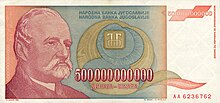This article may be a rough translation from Serbian. It may have been generated, in whole or in part, by a computer or by a translator without dual proficiency. (November 2023) |

Between 1992 and 1994, the Federal Republic of Yugoslavia (FRY) experienced the second-longest period of hyperinflation in world economic history[1] after that of 1920s Russia,[a] caused by an explosive growth in the money supply of the Yugoslav economy during the Yugoslav Wars.[3] This period spanned 22 months, from March 1992 to January 1994. Inflation peaked at a monthly rate of 313 million percent in January 1994.[4] Daily inflation was 62%, with an inflation rate of 2.03% in 1 hour being higher than the annual inflation rate of many developed countries. The inflation rate in January 1994, converted to annual levels, reached 116,545,906,563,330 percent (116.546 trillion percent, or 1.16 × 1014 percent). During this period of hyperinflation in FR Yugoslavia, store prices were stated in conditional units — point, which was equal to the Deutsche Mark. The conversion was made either in Deutsche Marks or in dinars at the current “black market” exchange rate that often changed several times per day.[5]
- ^ Cagan, Phillip (1956). "The Monetary Dynamics of Hyperinflation". In Friedman, Milton (ed.). Studies in the Quantity Theory of Money. Chicago: University of Chicago Press.
- ^ Palairet, Michael R. (2000). The Four Ends of the Greek Hyperinflation of 1941-1946. University of Copenhagen: Museum Tusculanum Press. pp. 9, 15–17. ISBN 9788772895826.
- ^ Hanke, Steve H. (2007-05-07). "The World's Greatest Unreported Hyperinflation". Cato Institute. Retrieved 2019-05-07 – via May 2007 issue of Globe Asia.
- ^ Bogetic, Zeljko; Petrovic, Pavle; Vujosevic, Zorica (1999-02-01). "The Yugoslav Hyperinflation of 1992-1994: Causes, Dynamics, and Money Supply Process". Journal of Comparative Economics. 27 (2): 335–353. doi:10.1006/jcec.1999.1577. S2CID 153822874.
- ^ O'Rourke, Breffni (9 April 2008). "Yugoslavia: Montenegro Adopts German Mark As Currency — But With Risks". Radio Free Europe/Radio Liberty. Retrieved 2020-02-19.
Cite error: There are <ref group=lower-alpha> tags or {{efn}} templates on this page, but the references will not show without a {{reflist|group=lower-alpha}} template or {{notelist}} template (see the help page).